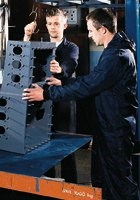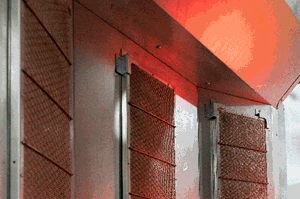Increasing Oven Line Speeds
Switching to a gas-fired radiant oven can increase curing speeds and reduce costs...
W. Lucy & Co. Ltd., Oxford, England, is an established firm whose traceable roots go back to 1812, but evidence shows it was established 52 years earlier. The present site, Eagle Ironworks, has been in continuous use with its foundry since 1825. Products from those early days, which were still being manufactured a century later, included agricultural machinery and ornamental ironwork.
Changes and additions to the company's products and markets have been influenced by the introduction of directors and executives with electrical engineering backgrounds from other industries. Among the products in the early 1900s were arc lamp posts and cast-iron electric street lighting posts. Designs for iron-clad fused cut-outs and disconnecting boxes were pioneered. An above-ground feeder pillar was introduced by Lucy, and examples from the 1920s remain in service today. In 1935, the company started producing electrical fittings in molded Bakelite.
The decision to concentrate on electrical engineering was made in 1943. In the immediate post-war years, new machining departments were started, and the foundry was redeveloped and expanded. Lucy installed its own electricity generating plant, which was the sole power source until the switch to a public supply in 1984. By that time, the company had the capability to produce more than six MVA (megavolt-amps). Self-sufficiency was further increased by 1960, with a short-circuit testing station of 200 MVA operational. Like many other engineering firms, Lucy experienced difficult times during the 1960s.
However, the next two decades produced amazing changes in the company's fortunes. Anew range of oil-filled, high-voltage ring main units was developed. The demand for this equipment overseas was exploited, particularly in Saudi Arabia. This led to the establishment of the Saudi Lucy Co., which assembles ring main units in a factory near Dahran, Saudi Arabia.
High standards of manufacturing and finishing are essential for the ring main units. Not only do they carry up to 24kV, but they are sited outdoors, often in exposed positions with extreme weather and temperature conditions and are expected to operate reliably and safely for a minimum of 25 years.
The latest step in a continuing program of updating and upgrading production methods is the installation of a Maywick Ltd., Chelmsford, England, gas-fired radiant oven to cure epoxy polyester powder coatings on a variety of components that make up ring main units. These range from internal and external fixing brackets and bosses to the complex fabrications that constitute the tanks that accommodate the oil-filled switchgear. These tanks may be as large as 35.31 cu ft and weigh 77 lbs. The successful cure achieved by these ovens is evidence of the effectiveness of high-temperature radiant heat on multi-surface products.
Pretreatment consists of shot-blasting and flame-coating with 100 microns of zinc. Components are then suspended from a heavy-duty overhead chain conveyor, with the aid of a Hymo lift table for heavy items. Conveyor speed is two fpm for smaller workpieces.
Epoxy polyester powder, 70 to 80 microns, is applied using manual guns before the products pass through the oven, which has a heat zone 18 ft long and five tiers high. Radiant energy is beamed at the workpieces by 120 surface combustion burners, each rated at 11,000 Btu/hr with an operating surface temperature of 1,562F. The burners are surrounded by highly polished stainless-steel cladding to ensure that all surfaces are cured satisfactorily.
The two walls of the oven are roller-mounted. The top and bottom tiers of the burner panels have a variable angle facility, enabling the energy profile to be adjusted to suit the size and configuration of the workpieces processed. Heat requirements can be regulated by adjustment of the burner intensity and partial shut-off facilities.
The new oven is the first stage in a planned upgrading of the finishing process, which will become fully automated and moved next to the production plant. It replaces an electric oven that failed to produce a consistently satisfactory cure.
A 50 pct increase in output and an energy savings of $975 per month are two of the benefits from the installation of the gas-fired radiant oven. The 50 pct increase in throughput provided by the oven has enabled Lucy to eliminate the night shift and switch the workers involved to the shot-blasting section. The energy savings of $975 per month was reported by component group manager John Ransome, who prefers the single-rate gas tariff to the electricity costs that varied with the time of day.
Related Content
Specialty Oven’s Hot Benefits and Other Questions Answered
Learn about the advantages of gas catalytic infrared pre-gel ovens in this article, including how they are energy efficient and can save users time and money when integrated into their existing systems.
Read MoreWicket Ovens Making a Comeback
International Thermal Systems supplies curing ovens designed to cure coatings applied to one side of a tinplate, aluminum, or steel sheet.
Read More5 Maintenance Tips for Gas Catalytic IR Ovens
Basic and periodic preventive maintenance is essential for avoiding oven downtime.
Read MorePowder Coating Overcomes Post Forming
Six Sigma methodology, open communication, and collaboration produce results for leading boat manufacturer.
Read MoreRead Next
A ‘Clean’ Agenda Offers Unique Presentations in Chicago
The 2024 Parts Cleaning Conference, co-located with the International Manufacturing Technology Show, includes presentations by several speakers who are new to the conference and topics that have not been covered in past editions of this event.
Read MoreEducation Bringing Cleaning to Machining
Debuting new speakers and cleaning technology content during this half-day workshop co-located with IMTS 2024.
Read MoreDelivering Increased Benefits to Greenhouse Films
Baystar's Borstar technology is helping customers deliver better, more reliable production methods to greenhouse agriculture.
Read More























